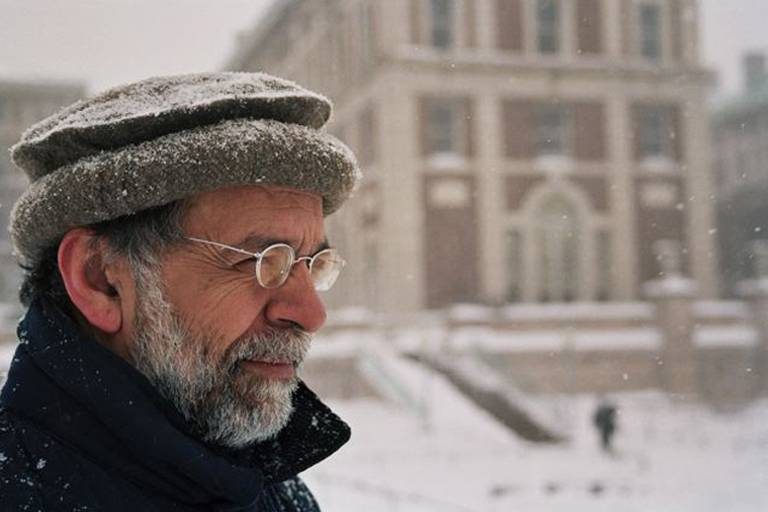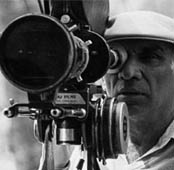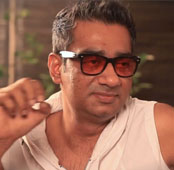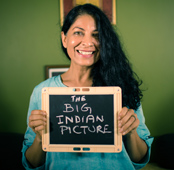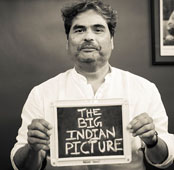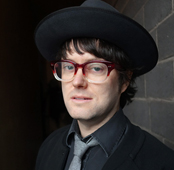Prof. Hamid Dabashi, 61, was born into a working class family in Ahvaz, Iran. Currently he is the Hagop Kevorkian Professor of Iranian Studies and Comparative Literature at Columbia University in New York, the oldest and most prestigious Chair in this field. He is also a founding member of the Institute for Comparative Literature and Society and the Center for Palestine Studies at the same University.
The writer of 25 books on a gamut of subjects, Dabashi is one of America’s most prominent, and sometimes controversial, liberal voices on politics, philosophy and culture. Banned from entering Iran, for his criticism of its government, he is equally reproachful of American policies towards his home state. A celebrated speaker, he is known for his razor-sharp one liners: ” …even if [Barack Obama] has sold his soul, … he used to have one. That is not the case with McCain.”
Dabashi also writes prolifically on cinema. He is credited with having brought to the fore the work of many luminary Iranian filmmakers. Mohsen Makhmalbaf has called him “a rare cultural critic”. His involvement with cinema extends to participating in international film festivals as a jury member and advising filmmakers such as Hany Abu-Assad (on Paradise Now) and Ridley Scott (on Kingdom Of Heaven). When Scott was attacked for recreating the war between Christian crusaders and Saladin in Kingdom Of Heaven he defended himself by saying he had the approval of “one very important Muslim in New York”.
When I meet Dabashi for a chat at The Imperial’s coffee shop in New Delhi, he cuts a formidable figure. In the middle of Delhi’s sweltering summer, with spectacles and a respectably grey beard, he sits upright in a neatly worn jacket which gives off a distinct Ivy League air. It is a clear Sunday morning. He and his wife, Dr. Golbarg Bashi, have just finished breakfast. He gets ready to field my questions as she sifts through some papers on the same table. He refuses to take coffee during this interview. For him, conversation is serious business.
You’ve spoken and written about politics and art, especially with reference to cinema. While cinema from Iran has won accolades around the world what impact does the cinema of, say, Abbas Kiarostami and Jafar Panahi, have on the people of Iran themselves?
This is a very good question. There are two sides to this. One side is that it’s not limited to Iranian cinema. The more a cinema, whether of India or Iran or China, is incorporated into the global film festival circuit the more distant it becomes from its own people. And the best examples are in the Iranian case. Filmmakers like, most recently, Abbas Kiarostami or (Mohsen) Makhmalbaf have for one reason or another not been able to make films in their own country and that has affected their cinema. They continue to be celebrated in film festivals, but their films are scarcely seen inside Iran, let alone have an impact.
Satyajit Ray, perhaps the greatest Indian filmmaker ever, was more loved and admired in the global context. But he was loved and admired in India too, because he continued to be nourished in his own country.
But despite the fact that these films are not seen, they can be tuned to the aesthetic intuition of the people. They emerge out of the cultural subconscious of the people. And they continue to be nourished by it, even if they are not permitted by state censorship to give back. But the circularity of creativity is exhausted by the censorial policies of the state.
Still, given the condition of the modern media, it is possible for at least a significant proportion of people to continue to see this cinema. I’m persona non grata in Iran because of my very clear political position. I can’t go to Iran. But I constantly see Iranian cinema in film festivals or when filmmakers send me their DVDs— and there are a number of other possibilities that ensure films get circulated. If films are banned in Iran, it doesn’t mean they are not seen. In fact, if a film is banned that itself is a good reason for us to go on and see it. So states are no longer as capable of censoring cinema as they once were.
But nevertheless the point remains that these censorial policies are crippling the subconscious of the people of Iran. This has always been the case, even under the former Pahlavi regime.
Let’s talk about popular and art cinema. In the case of Ray, it took a while for his cinema to be accepted by the people, but he finally found his local audience, at least among the people of West Bengal, if not India. In Iran, there has been a popular cinema. Besides the censorship there is the concern that if something is too meaningful or complex it won’t have a wide popular reach…
That is not a problem and again that is not endemic to Iran. Take the case of the US— when people think of American cinema they don’t think of Jim Jarmusch, they think of Hollywood. Proportionately as many Iranians know about their cinema as art as Indians do, or as Americans do. How many Indians know of Mani Kaul? If a statistically significant portion of the society: the political community, the hermeneutic circle and public intellectuals, recognizes the significance of a work of art, and continues to write about it, that becomes a conduit.
The difference between India and Iran is that India is a healthy society that’s allowed to grow. Iran is a healthy society, but has a sick government that doesn’t allow the natural growth of its hermeneutic circle. When there’s a movie by Abbas Kiarostami or Makhmalbaf one critic likes it, another critic does not, and they can both write their opinion. Then society at large becomes a beneficiary because word goes out. Some people pay attention to it and some people do not, but word goes out.
India is the perfect model of that society. It doesn’t mean that the state doesn’t have its problems and India doesn’t have censorial policies or there’s no repression. It does. But judging by the fact that you can have a film festival like the Osian’s Cinefan Film Festival in the capital, it is a healthy society. Filmmakers make their films. Some are good. Some are bad. They have issues— sex, politics, violence. But it is the hermeneutic community around a work of art that recommends what should be seen, or not. Sometimes one person likes a film, another person doesn’t like it, and you get both views. It is not for one state bureaucrat to decide what seventy five million human beings should or should not see.
During the 2009 Iran protests, you gave a speech in a seminar that you ended with an allegory from The Godfather. You referenced Don Corleone telling his son Michael that whoever would come to him with a deal would be the traitor. Similarly, you said, whoever said that these protests would lead to a regime change in Iran would be lying. Is there anything that can lead to a regime change in Iran, according to you? And can cinema play any role in this at all? Something like the cinephile movement (of France in 1968)… ?
The metaphor that I use for the democratic movement in Iran is that of an adolescent growing body that has clothes on it that don’t fit. Those clothes are the state. The growth of the body politic of Iran is apace. A very young and ambitious population is manifested in its cinema, poetry, drama, journalism and public intellectuals. And the state that is governing it is outdated and condemned to the dustbin of history. But, as with all other oppressive regimes, the state continues to use violence to stay in power. This social movement predates the formation of the Islamic republic, and will outlast it. The Islamic republic will either adjust to this growing body and remain, or not adjust and be discarded in time.
The society, which is a public sphere will continue to be enriched by one form of cultural expression or the other. Cinema is integral to this but that doesn’t mean that it will remain integral. The reason is that the cultural manifestations of a society are promiscuous, not monogamous. The cultural manifestation of Iranian society used to be poetry. Then it became fiction. Then it became cinema. Right now it is blogging and underground music which, in fact, are more in tune with the pulse of the society than cinema. But that has less to do with censorial policies and more to do with the inner dynamics and inner episteme of cultural manifestation— that one manifestation hits a plateau. In my book Masters And Masterpieces Of Iranian Cinema I posit a semi-formation around twelve films at the end of which I conclude that that epistemic synergy has exhausted itself where cinema is concerned and has now moved into other directions, possibly underground music and blogging. But that doesn’t mean it will remain there either, it keeps evolving.
Let’s discuss this plateau you’re talking about that cinema has reached. What is the reason for cinema to have given way to underground music or blogging as primary forms of cultural expression today?
To me cultural expressions of a society vary and are decided by two forces. One is societal forces that change it. And another is the inner dynamics of cultural expression, whether it is poetry or cinema or drama or whatever. My argument has been that since the constitutional revolution in Iran, which took place between 1905 and 1907, poetry became the most important modus operandi of culture in relation to politics. This continued until the 1930s when fiction and prose picked up and then in the 1960s cinema took over. And in the course of the (Islamic) revolution and the Iran-Iraq war, the trauma of these gave a volcanic outburst to Iranian cinema in the 1980s. These are the social conditions.
But then in Masters And Masterpieces Of Iranian Cinema I go through the various formations of realism. I don’t call the whole thing neorealism. The realism of Kiarostami is different from Makhmalbaf which is different from (Dariush) Mehrjui which is different from (Amir) Naderi. But they’re all different forms of realism. And by tabulating and theorizing those forms of realism in Iranian cinema, I argue that that epistemic mode of realistic cinematic production has exhausted itself. It’s not that Makhmalbaf or Kiarostami or Panahi will not continue to create fantastic films. But my proposition is that they will be more on the model of a post Koker-trilogy of Kiarostami where they will keep repeating themselves. There will be no inroads to new discovery until something happens. In the Osian film festival I saw a fantastic film called Modest Reception which I think has new possibilities. But a cinematic movement doesn’t show itself with just one film. One has to be patient and watch. But the sense that I get now, after the proliferation of underground music and blogging, is that these are the forms of cultural expression to watch out for where Iranian society is concerned.
Though cinema ultimately is the most complete medium. It has stories, it has fiction, it has poetry, it has drama, it has everything. So as with the rise of cinema in the ’60s with filmmakers who were the beneficiary of every other art form I wouldn’t be surprised if the emerging cinema became a beneficiary of underground music. Forugh Farrokhzad, for instance, was an important filmmaker as well as a big poet in the 1960s. Similarly Bahman Ghobadi’s No One Knows About Persian Cats today is a film which tries to come to terms with the underground music movement in Iran.
But I do provide an argument in Masters And Masterpieces… that that particular kind of cinema that began with Forugh Farrokhzad and came to the forefront with people like Naderi and (Bahram) Beizai, then came to full fruition with the cinema of Kiarostami and Makhmalbaf, has completed its cycle.
You’re involved in a Palestinian film festival called Dreams Of A Nation. What do you hope to achieve with this?
When it comes to Dreams Of A Nation, my responsibility is that of an archivist. Like everybody else I have my ideas on Palestinian cinema, of preferring one filmmaker to another filmmaker— but here because of the absence of archives, because of the trampling of the archives by the Israelis in every way conceivable, and because of the scattered nature of where Palestinian filmmakers are I would like to fulfill my role as an archivist first. Palestinians don’t have any cine-clubs, they don’t have any infrastructure or a foundation on which to build a cinema culture, they don’t have any major source of funding. And till very recently there was not even one movie theatre in East Jerusalem where they could show their films.
But, of course, it is impossible to imagine in a condition like the Palestinian condition for cinema not to have an immediate impact on its people. I observed inside Palestine that Palestinians were extremely attracted and connected to their cinema – perhaps precisely because they don’t have the infrastructure. So people were projecting a film in the Sakakini Foundation (The Khalil Sakakini Cultural Centre Foundation) in Ramallah under very harsh circumstances while the Israeli army jeeps are driving by. The projector here was not even a proper projector and circumstances were very dire, but that made the experience far more significant than watching a movie in a fantastic movie theatre in Tel Aviv. This political condition is momentous and of extraordinary significance to Palestinian cinema.
However, this creates an aesthetic crisis. How do you represent something which is unrepresentable, where reality out-exaggerates any fiction, where fiction cannot out-exaggerate reality, in order to show it.
They have what I call a mimetic crisis in Palestinian cinema. And the creativity and genius of Palestinian filmmakers, particularly someone like Elia Suleiman is how to train that mimetic crisis into something positive. To me, in fact, the aesthetic particularity of a filmmaker like Elia Suleiman, whom I consider one of the greatest living filmmakers, would not be possible without that mimetic crisis. A particularity such as a certain kind of non-linear narrative, for instance.
Six years ago you were very critical of a book called Reading Lolita In Tehran, a personal account of a woman’s journey in post-revolution Iran, and you actually compared the author Azar Nafisi to an American soldier abusing prisoners in Abu Ghraib. When you look back do you feel you were too harsh?
Listen, I wrote that essay at a moment when we were in a very critical condition of impending military strike against Iran. I’m very critical of the Ahmadinejad regime which misrepresents the political culture of Iran and is repressive. But I’m against military strike. And I’m against putting economic sanctions on Iran. So when I look at the issues from the perspective of someone living in New York, and not only someone who is anti-war against Iran, but anti-war against Afghanistan, Iraq, Somalia and Libya as well—I’m consistent on my position—and when I feel eventual manufacturing of consent, as Noam Chomsky says, by use of human rights, or women’s rights, or repression or torture, I become critical. All of these things are true. But who is to be at the forefront of fighting against them? Not an expatriate professor of English in Washington DC who frequents the White House and frequents the State Department, but the Iranian people.
So I think that our responsibility when we live in the United States is a double edged sword. You should never let go of criticizing Islamic republics severely as they deserve to be criticized. But you need to be simultaneously, in the same sentence, critical of the aggressive, violent, new cochonnerie of the right wing in the United States and their warmongers. And when I see one is gung-ho on one and silent on the other I become critical. I’m equally critical of people who never say anything of the oppression in Iran. Was my language harsh? When I think now, many years later, perhaps. What was my thinking? What I just said.
Besides bringing Palestinian stories to the fore, does cinema in Palestine also make its citizens question themselves? What role does cinema play among the people in the country?
Yes, but here again we have to consider the absence of infrastructure. Palestinians are in occupied territories and also in refugee camps outside their country. I went to a Palestinian refugee camp in Lebanon. And I took a backpack full of Palestinian films to show them, in really disheartening conditions. There was no electricity. There was mismatched equipment. We were projecting onto walls. At this stage, the conditions are so dire that the sheer attempt is to remind Palestinians that they have a cinema, and filmmakers. That there are people who care about them who are Palestinians, or Palestinian at heart, and who go through the thick and thin of the world’s politics to document their condition. This is a huge support that they need. Hopefully cinema will eventually enable them to see their state and reflect on it, and talk about it. At this stage, Palestinians who are not under occupation— who are outside Palestine or live in Europe and North America etc. are really miniscule in number.
However, through avenues such as Al Jazeera, and through international film festivals—like right here in Delhi (in the Osian Cinefan’s Film Festival) we watched a Palestinian film and we had a filmmaker in the jury who just finished her new film—it is possible to create a simulacrum of a space where Palestinians can show their films to Palestinians and get feedback. But at this stage in Palestine, when they have a nation but no nation state and hardly any infrastructure, it is very difficult.
You have often said that we should try to be ‘cosmopolitan’ not ‘secular’.
Yes. Yes. Yes. Tomorrow we have a conversation with Prof. (Ashis) Nandy. His thoughts are very similar to mine. He has written against secularism. I don’t write against secularism. I just don’t have any use of the word ‘secular’ because it glosses over a reality that creates a false binary between ‘religious’ and ‘secular’.
The one thing I like about Islamic society, culture and history is that it has always been in conversation within itself and without itself. Within itself the Islam of the mystic is different from the Islam of a jurist or of a philosopher. And in the course of history, Muslim philosophers and Muslim jurists have been in conversation and conflict with each other too. And the definition of Islam has benefited from this conversation. And Islam will always be in conversation with realities outside it. Islamic philosophy became possible because of conversation with Greek philosophy. Islamic aestheticism became possible because of conversation with Christian and Buddhist aestheticism. Islamic theology arose out of conversation with Jewish theology. And I call that reality cosmopolitan worldliness that crossed over the last two hundred years, after which you have a transformation of the Islamic cosmopolitan worldliness into a singular site of ideological conversation with the West. And my point, now, is that this period of binary opposition of Islam and the West has fortunately exhausted itself and entered a new phase. What is that new phase? The retrieval of cosmopolitan worldliness not by way of an antiquarian interest in it, but by recognizing the contemporary world.
Can American popular cinema play a role in influencing the way the West perceives the Muslim World? To rid people’s minds of Samuel P. Huntington’s idea of the ‘Clash Of Civilizations’ for instance?
Officially it can. But movies that constitute popular culture like the movie 300 or, of late, the last movie in the Batman trilogy (The Dark Knight Rises), their kind of cinematic allegory is in fact conducive to the constitution of the Muslim other as the absolute, unconditional enemy of the state, of the empire. This is an unconditional and vicious demonization of the Muslim other.
Can it play a corrective role? Yes of course it can. And there are many American films that ease this Islamophobia. But popular culture, because it caters to the basic and most common denominator— the gut feeling of the society, it continues to vacillate.
Is there a way to counter this? You’ve been ‘chief adviser’ to Ridley Scott on his characterization of Saladin for the film Kingdom Of Heaven…
That is but one example. The thing is that even before he made Kingdom Of Heaven the script that he had was so brilliant. Not because of William Monahan (the screenwriter) or because I was a consultant, but because of the character of Saladin. It would have been practically impossible to destroy who Saladin was, and his magnanimity and generosity of spirit.
But the fact that Sir Ridley went to the character of Saladin, that Monahan wrote that fantastic script, and that between the two of them they approached somebody like me to become their consultant, all points to the fact that there are countervailing forces who can go through the period of history, find a positive character and make a fantastic epic. But despite Kingdom Of Heaven being critically acclaimed, making a lot of money and becoming very popular it comes nowhere near the significance of the Batman trilogy or 300, which became a cult movie.
But in that case isn’t there need for a more co-ordinated effort or forum to exchange ideas on this issue with the makers of popular Hollywood films?
Yes of course there is. The thing is Muslims in United States or in the Arab world— they don’t have the wherewithal to mobilize such a thing. So the best we can do is with critical intimacy.
There are two aspects. If you just say Hollywood is demonic, it doesn’t work. You need to have critical intimacy with popular culture, with Hollywood. Critical, but intimate at the same time. And it is through that that you can have great impact. Another great movie was the movie Crash where you have multiple representations of not just Muslims, but other minority groups in the United States— a very loving caring depiction, yet interwoven in a complicated way. So that no one comes across as evil, or angelic.
Coming back to Iran, there have been films, world over, which have sparked off movements of protest by engaging with a public mood. Has there been any such film in Iran? If not do you see the possibility of such a film?
Not in recent times. The movie A Separation, was a great movie, and had a great reception outside Iran— but became more of a global hoopla than it was in Iran. Partially because the difference between the Pahlavi regime and the Islamist republic is the difference between an authoritarian regime and a totalitarian regime. In the authoritarian regime of Pahlavi there was room for the possibility of virulent discussion. In the totalitarian regime of the Islamic republic, they are very conscious of not letting anything of that sort emerge. A movie such as Amir Naderi’s Saz Dahani (Harmonica) became what you said, where people stormed out of movie theaters after it and there were rallies and demonstration. But that was in 1974. Nothing of that sort is possible under the Islamic republic, that took over in 1979, because it is so totalitarian, so conscious of its own absence of legitimacy, that it kills everything in the bud.
But even in a movie like A Separation that has nothing to do with the state directly, there are implications: Why is it that the wife wants to leave Iran? Why is it that the husband is not disagreeing? Why do they want to leave the country, even when he has a father that they have to take care of? Or in the case of (Asghar) Farhadi’s (the director of A Separation) Oscar acceptance speech in Hollywood, that very act becomes an occasion for people to express their solidarities with a filmmaker, their hopes for a better life, and their defiance of the censorial policy. And, as you know, the speech was altered and dubbed by the government and they had him make a statement about the Iranian nuclear program, something he had not, of course, said. Any such occasion becomes a point of protestation between the society and the state. So I’m not waiting to see something like what you mentioned to happen because I realize that notes of dissatisfaction within society can have multiple expression.
Iran, Islam and The Movies.
InterviewNovember 2012
 By Rishi Majumder
By Rishi Majumder
Rishi Majumder is Senior Editor at The Big Indian Picture.


